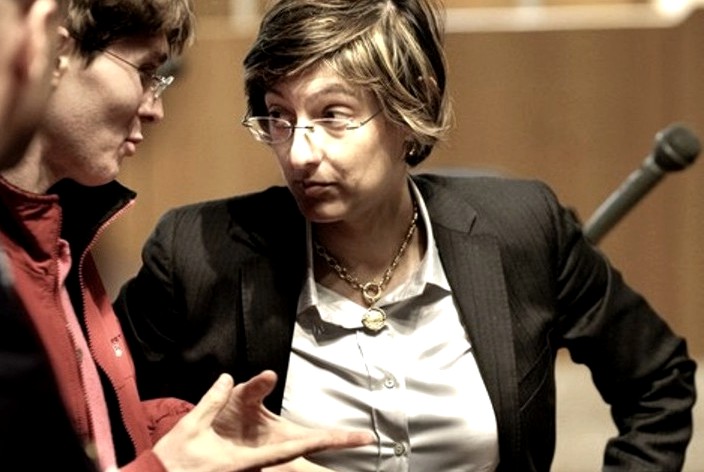
Category: 15 Single alibi hoax
Sunday, May 12, 2013
Demonizations By Knox: OGGI Charged For Article Conveying False Claims To Italy #2
Posted by Our Main Posters
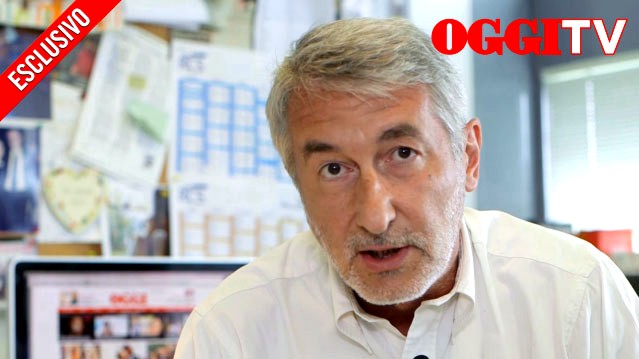
[Umberto Brindani, editor of Oggi, a Mario Spezi ally, being sued for publishing Knox’s claims in Italy]
The decision of Amanda Knox and her lawyers and publishers to flaunt her dishonest claims in Italy seems seriously ill advised.
Pouring gasoline on the fames, it has opened up a fast-track way for those many who she nastily attacks to put the real truths in front of the world. Nobody who foolishly parrots her will be immune from being required to testify by the courts, her own lawyers included.
Here are our own short rebuttals of the Knox claims Oggi specifically flaunts to Italy in its unresearched review.
- Knox was NOT interrogated for days and nights. She was put under no pressure in her brief witness interviews except possibly by Sollecito who had just called their latest alibi “a pack of lies”.
- Knox WAS officially investigated in depth, after she surprisingly “confessed” and placed herself and Patrick at the scene. Prior to that she’d been interviewed less than various others, who each had one consistent alibi.
- Knox herself pushed to make all three statements without a lawyer on the night of 5-6 November 2007 in which she claimed she went out from Sollecito’s house, met Patrick, and witnessed him killing Meredith.
- Far from Knox being denied a lawyer, discussions were stopped before the first statement and not resumed, in the later hearing she was formally warned she needed one; she signed a confirmation of this in front of witnesses.
- Prosecutor Mignini who Knox accuses of telling her a lawyer would hurt her prospects when she claims she asked for one was not even in the police station at that interview; he was at home.
- She was not prohibited from going to the bathroom. At trial, she testified she was treated well and was frequently offered refreshments. Her lawyers confirmed this was so.
- She was not given smacks by anyone. Over a dozen witnesses testified that she was treated well, broke into a conniption spontaneously, and thereafter was hard to stop talking.
- There is no evidence whatsoever that Knox was subject to “something similar to torture” and as mentioned above only Sollecito applied any pressure, not any of the police.
- There is nothing “suicidal” about returning to Italy to defend herself at the new appeal. Sollecito did. She risks an international arrest warrant and extradition if she doesn’t.
- There is no proof except for her own claims of sexual molestations in prison; she is a known serial liar; and she stands out for an extreme willingness to talk and write about sex.
- Many people have testified she was treated well in prison: her own lawyers, a member of parliament, and visitors from the US Embassy were among them; she herself wrote that it was okay.
- She may have based her account on her diaries and “prodigious memory” but the obviously false accusation against the prosecutor suggests that much of the book was made up.
- The investigators had a great deal of evidence against Knox in hand, not nothing, and they were not ever faulted for any action; they helped to put on a formidable case at trial in 2009.
- “Police and Italian justice work with such incompetence, ferocity, and disdain for the truth” is contradicted by a very complete record prior to trial which was praised by the Supreme Court.
- Mr Mignini has NO bizarre past at all. He is widely known to be careful and fair. He would not have been just promoted to first Deputy Prosecutor General of Umbria otherwise.
- He was put on trial by a rogue prosecutor desperate to protect his own back from Mignini’s investigations; the Supreme Court has killed the trumped up case dead.
- There was nothing “mysterious” about Knox being taken to the crime scene to see if any knives were gone, but her wailing panic when she saw the knives was really “mysterious”.
- Knox never thought she was in prison for her own protection; she had signed an agreement at the 5:00 am interview confirming she did know why she was being held.
- Monica Napoleoni did not “bluff” that Sollecito had just trashed their joint alibi; he actually did so, because his phone records incriminated him; he agreed to that in writing.
- There was no crescendo of “yelling and intimidations that lasts from 11 at night until 5.45”. There were two relatively brief sessions. Knox did most of the talking, named seven possible perps, and drew maps.
- There was zero legal requirement to record the recap/summary interview, no recording has “gone missing” and many officers present testified to a single “truth” about what happened.
Demonizations By Knox: OGGI Charged For Article Conveying False Claims To Italy #1
Posted by Our Main Posters

The popular Italian magazine Oggi was sent a review copy of Knox’s book by somebody in the United States.
Oggi has been a frequent vehicle for the Knox entourage version of events, and it has carried a number of lurid pro-Knox splashes. The magazine has a long history of nasty jabs at prosecution and police who as career civil servants under unusually strong rules have no easy ways of explaining their side.
Like all of Oggi’s articles on the case, this shrill and foolish piece is totally one-sided and absolutely unresearched.
- Oggi is ignorant of the fact that many days of testimony by police officers at trial in 2009 contradict Knox’s book, highly convincing testimony, to which Knox on the stand had only the most feeble and unconvincing of responses.
- Oggi is ignorant of the fact that Judge Massei and even Judge Hellmann disbelieved her, and (in extensive reasoning) the Supreme Court (make sure to read parts 3, 7 and 15 there).
- Oggi is ignorant of the fact that Knox was sentenced to three years in prison for the criminal framing of Patrick, and that sentence was confirmed both by Judge Hellmann and the Supreme Court - in effect, unless new FACTS come to light, the truth is known and the case is closed.
The book is already (see next post) the subject of a lawsuit which was filed Friday in Bergamo, where Oggi has its headquarters. Knox is also expected to be investigated for contempt of court. Her book carries at least one no-contest false accusation of a crime: Knox claims the much respected Prosecutor Mignini illegally interrogated her without a lawyer and attempted to make her definitively accuse Patrick Lumumba. This is repeated below. In fact Mr Mignini was not even there.
This translation below of the Oggi piece is by our main poster Catnip. Passages that can EASILY be shown to be false (Oggi would have known they were false with a mere 3-4 hours of research) are highlighted here.
See our own rebuttals in this next post.
Amanda Knox: The American girl’s sensational story
Chilling. No other adjectives come to mind after having read Waiting to be Heard, finally released in the United States. An extremely detailed and very serious charge against the police and magistrates who conducted the investigation into the murder of Meredith Kercher.
Immediately after the crime, Amanda recounts, and for entire days and nights, they had interrogated the American girl and placed her under pressure to make her confess to a non-existent truth, without officially investigating her, denying her the assistance of a lawyer, telling her lies, even prohibiting her from going to the bathroom and giving her smacks so as to make her sign a confession clearly extorted with something similar to torture.
And now the situation is very simple. There are only two choices: either Amanda is writing lies, and as a consequence the police officers and magistrates are going to have to sue her for defamation; or else she is telling the truth, and so they are going to have to go, not without being sanctioned by the CSM [the magistrates’ governing body] and the top brass of the Police. The third possibility, which is to pretend that nothing has happened, would be shameful for the credibility of our judicial system.
Amanda Knox has written her Waiting to be Heard memoir with the sense of revulsion and of relief of someone who has escaped by a hair’s breadth from a legal disaster, but has got her sums wrong. Cassation has decided that the [appeal] proceedings have to be redone and the hearings should be (re)commencing in October before the Florence Court of Appeal.
In a USA Today interview, Ms Knox has not excluded the possibility of “returning to Italy to face this battle too”, but it would be a suicidal decision: it’s likely that the appeal will result in a conviction, and the Seattle girl will end up in the black hole from which she has already spent 1,427 days.
In this way Waiting to be Heard risks being the “film” on which Amanda’s last words are recorded about the Mystery of Perugia, her definitive version.
We have read a review copy. And we were dumbfounded. Waiting to be Heard is a diary that has the frenetic pace of a thriller, written in a dry prose (behind the scenes is the hand of Linda Kulman, a journalist at the Huffington Post), even “promoted” by Michiko Kakutani, long-time literary critic at the New York Times.
The most interesting part does not concern the Raffaele Sollecito love story (which Amanda reduces it to puppy love: “With the feeling, in hindsight, I knew that he… that we were still immature, more in love with love than with each other”), and whoever goes looking for salacious details about the three Italian boys Amanda had casual sex with, one night stands, will be frustrated (Ms Knox describes those encounters with the nonchalance of an entomologist disappointed with his experiments: “We undressed, we had sex, I got dressed again with a sense of emptiness”).
There are no scoops about the night of the murder and even the many vicissitudes endured during the 34,248 hours spent in Capanne prison - the [claimed] sexual molestations suffered under two guards, the unexpected kiss planted by a bisexual cellmate, the threats made by another two prisoners - remain on the backdrop, like colourful notations.
Because what is striking and upsetting, in the book, is the minute descriptions, based on her own diaries, on the case documents and on a prodigious memory, of how Ms Knox had been incriminated (or “nailed”).
COME IN KAFKA. A Kafkian account in which the extraordinary naivety of Amanda (the word naïve, ingénue, is the one which recurs most often in the 457 pages of the book) mixes with the strepitous wickedness of the investigators decided on “following a cold and irrational trail because they had nothing better in hand”.
Devour the first 14 chapters and ask yourself: is it possible that the Police and Italian justice work with such incompetence, ferocity, and disdain for the truth? You place yourself in her situation and you scare yourself: If it happened to me? You’re in two minds: is it a likely accusation, or a squalid calumny, the version of Amanda?
Because in reading it you discover that in the four days following the discovery of Meredith Kercher’s body (on 2 November 2007), Amanda was interrogated continuously, and without the least of procedural guarantees [=due process].
She changes status from witness to suspect without being aware of it.” No one had told me my rights, no one had told me that I could remain silent”, she writes. When she asked if she had the right to a lawyer, the Public Prosecutor, Giuliano Mignini, had responded like this: “No, no, that will only worsen things: it would mean that you don’t want to help us”. Thus, the Public Prosecutor, Giuliano Mignini.
For a long period of time, Ms Knox, who at the time spoke and understood hardly any Italian at all, mistook him for the Mayor of Perugia, come to the police station to help her.
Then, with the passage of time and of the pages, the assessment changes: Mignini is a prosecutor “with a bizarre past”, investigated for abuse of office (he was convicted at first instance, but Cassation annulled the verdict on the grounds of lack of jurisdiction: the case will be tried again in Florence) and with the hunger to fabricate “strange stories to solve his cases”.
Mignini “is a madman who considers his career more important than my liberty or the truth about the killing of Meredith”. On the phone, the Perugian prosecutor reacts with aplomb: “First I will read the book and then I will consider it. Certainly, if it really calls me “˜mad’ or worse, I think I will file suit”.
BEING IN PRISON IS LIKE CAMPING Amanda goes looking. When the officers mysteriously bring her along to the crime scene inspection of the apartment below the one in which she and Meredith were living in, Ms Knox put on the shoe protectors and the white forensics gloves and called out “ta-dah!” spreading her arms “as if I was at the start of a musical: I wanted to appear helpful”.
When they dragged her in handcuffs into Capanne Prison, she believed what the Police would have told her, and that was they would hide her for a couple of days to protect her (from the true killer, one presumes) and for unspecified bureaucratic reasons. “In my head I was camping: ‘This won’t last more than a week in the mountains’ I told myself” writes Amanda.
They take her money off her, and her credit cards, licence [?] and passport, and she draws strength from repeating to herself that “surely they’re not going to give me a uniform, seeing that I’m a special case and that I’ll be here for only a little while”.
But it’s the account of the notorious interrogation that takes the breath away. Around ten in the evening on her last day of freedom, Ms Knox accompanies Raffaele to the police station (he was called in, also without a lawyer, by the Police) and is thrown into a nightmare which she populates with many faces: there is Officer Rita Ficcara, who gives her two cuffs on the head (“To help you remember” she would say); there’s another officer who advises her: “If you don’t help us, you’ll end up in prison for 30 years”; Mignini arrives and advises her not to call a lawyer; super-policewoman Monica Napoleoni dives in and bluffs: “Sollecito has dropped your alibi: he says that on the night of the murder you had left his apartment and that you had told him to lie to ‘cover you’ “.
And a crescendo of yelling and intimidations that lasts from 11 at night until 5.45 in the morning. Seven hours “produce” two confessions that, exactly because they are made without a defence lawyer, cannot be used in the proceedings, but forever after “stain” the image of the accused Knox: Amanda places herself at the scene of the crime and accuses Patrick Lumumba.
RAFFAELE CONFIRMS THE ACCUSATIONS An account of the horror is confirmed by Sollecito in his memoir, Honor Bound, Raffaele writes of having heard “the police yelling at Amanda and then the cries and sobs of my girl, who was yelling “Help!” in Italian in the other room, and of having being threatened in his turn (“If you try to get up and go, I’ll punch you till you’ll bleed and I’ll kill you. I’ll leave you in a pool of blood”, another officer had whispered to him).
Published lines which have passed right under the radar of the Perugian investigators: “No legal action [against the interrogators] has been notified to us,” Franco Sollecito, Raffaele’s dad, tell us. For having recounted the sourness of her interrogation in court, Amanda was investigated for calunnia: the trial will take place in Florence. This one, too, will be a circumstantial case: it’s the word of two young people against that of the public prosecutor and the police.
The recording of the interrogation would have unveiled which side the truth stands on. But it has gone missing.
See our own rebuttals in this next post.
Below: images of the 4-page Oggi spread. Click for larger versions to read.

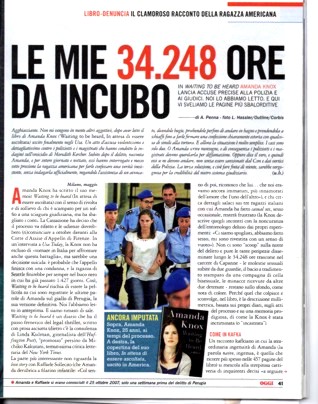
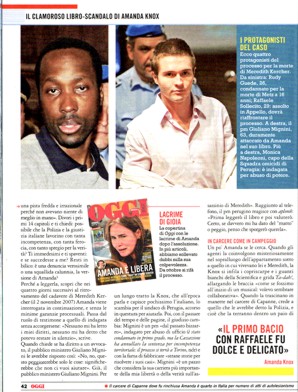
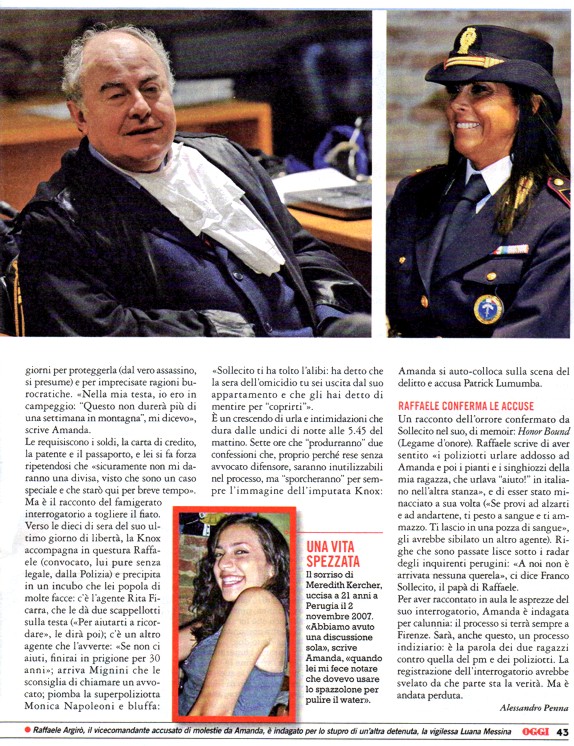
Thursday, May 09, 2013
Demonizations By Knox: She Invents An Illegal Interrogation By Mignini That Never Took Place
Posted by Our Main Posters

[The Perugia Central Police Station where Knox’s imaginary interrogation “took place”]
It is hard to imagine a more extreme form of contempt of court than Knox falsely accusing a respected prosecutor of interrogating her without her lawyer being present, and pressing her to incriminate others.
For this alone, Knox will certainly be investigated and charged. No wonder she is “scared” of returning to Italy. Apart from fears of getting up on the stand, she has lied about and falsely accused way too many people there.
1. What actually happened at Knox’s witness and suspect interviews:
Here is the true account, which has many witnesses, and then her account in the book, which has none.
Before 3:00 AM on 6 November 2007 the respected senior prosecutor Giuliano Mignini had barely set eyes on Amanda Knox.
At that point in time, she had just passed through a purely voluntary witness questioning with the police, who were actually much further ahead in questioning Sollecito and Knox’s flatmates and Meredith’s English friends.
Dr Mignini was at home asleep, but on call if the central police station needed him that night, which is how quite by chance he came face to face with Knox not long before dawn.
Knox’s latest alibi had just been collapsed in another witness interview room. Sollecito had collapsed their joint alibi almost instantly when shown phone records that proved he had just lied. He then declared their current alibi to be a pack of lies.
Told of this, Knox then floundered for a new explanation, turning finally to fingering her employer Patrick Lumumba who the police did not even know to exist until her phone record showed he did.
Police took down that statement, Knox signed it, and this at 3:00 am was the state of play.
Knox was in a waiting room and not under arrest. Mignini was required to warn Knox of her rights as a new suspect, and to warn her to do no further talking to him or anyone else around without a lawyer present.
This was especially so as Knox was inclining to babble on and on and officers were trying to calm her down. As the police had just found (and as her own lawyers later found) she can prove very difficult to stop.
This relatively brief meeting (in which Mignini made quite clear who he was, witnesses confirm) was extended to allow Knox to fine-tune her accusation of Patrick.
She shrugged off the right to have her lawyer there. Prior to this, Knox to Mignini was simply one of a whole lot of people who might be of interest, nothing more.
2. Knox’s invented version of the witness interview which never happened
This interrogation quoted from Knox’s book below is already attracting serious attention in Italy. Why? Because its just not her babbley tone, and because it never even took place.
Amanda Knox, Waiting To Be Heard, HarperCollins, Pages 90-92
[Description is of the end of Knox’s voluntary witness interview with police which Mignini did not attend; the most damaging claims are in bold]
Eventually they told me the pubblico ministero would be coming in.I didn’t know this translated as prosecutor, or that this was the magistrate that Rita Ficarra had been referring to a few days earlier when she said they’d have to wait to see what he said, to see if I could go to Germany.
I thought the “public minister” was the mayor or someone in a similarly high “public” position in the town and that somehow he would help me.
They said, “You need to talk to the pubblico ministero about what you remember.”
I told them, “I don’t feel like this is remembering. I’m really confused right now.” I even told them, “I don’t remember this. I can imagine this happening, and I’m not sure if it’s a memory or if I’m making this up, but this is what’s coming to mind and I don’t know. I just don’t know.”
They said, “Your memories will come back. It’s the truth. Just wait and your memories will come back.”
The pubblico ministero came in.
Before he started questioning me, I said, “Look, I’m really confused, and I don’t know what I’m remembering, and it doesn’t seem right.”
One of the other police officers said, “We’ll work through it.”
Despite the emotional sieve I’d just been squeezed through, it occurred to me that I was a witness and this was official testimony, that maybe I should have a lawyer. “Do I need a lawyer?” I asked.
He said, “No, no, that will only make it worse. It will make it seem like you don’t want to help us.”
It was a much more solemn, official affair than my earlier questioning had been, though the pubblico ministero was asking me the same questions as before: “What happened? What did you see?”
I said, “I didn’t see anything.”
“What do you mean you didn’t see anything? When did you meet him?”
“I don’t know,” I said.
“Where did you meet him?”
“I think by the basketball court.” I had imagined the basketball court in Piazza Grimana, just across the street from the University for Foreigners.
“I have an image of the basketball court in Piazza Grimana near my house.”
“What was he wearing?”
“I don’t know.”
“Was he wearing a jacket?”
“I think so.”
“What color was it?”
“I think it was brown.”
“What did he do?”
“I don’t know.”
“What do you mean you don’t know?”
“I’m confused!”
“Are you scared of him?”
“I guess.”I felt as if I were almost in a trance. The pubblico ministero led me through the scenario, and I meekly agreed to his suggestions.
“This is what happened, right? You met him?”
“I guess so.”
“Where did you meet?”
“I don’t know. I guess at the basketball court.”
“You went to the house?”
“I guess so.”
“Was Meredith in the house?”
“I don’t remember.”
“Did Patrick go in there?”
“I don’t know, I guess so.”
“Where were you?”
“I don’t know. I guess in the kitchen.”
“Did you hear Meredith screaming?”
“I don’t know.”
“How could you not hear Meredith screaming?”
“I don’t know. Maybe I covered my ears. I don’t know, I don’t know if I’m just imagining this. I’m trying to remember, and you’re telling me I need to remember, but I don’t know. This doesn’t feel right.”
He said, “No, remember. Remember what happened.”
“I don’t know.”At that moment, with the pubblico ministero raining questions down on me, I covered my ears so I could drown him out.
He said, “Did you hear her scream?”
I said, “I think so.”My account was written up in Italian and he said, “This is what we wrote down. Sign it.”
To repeat, Mignini was not even present at the midnight interrogation of Knox by the police, and he certainly never edged her into fingering Lumumba as is being claimed here. Knox herself did that all by herself in the presence of the police.
And she did it again and again. Emphatically.
[Dalla Vedova and Ghirga: did they illegally allow Knox to commit serious felonies in the book?]
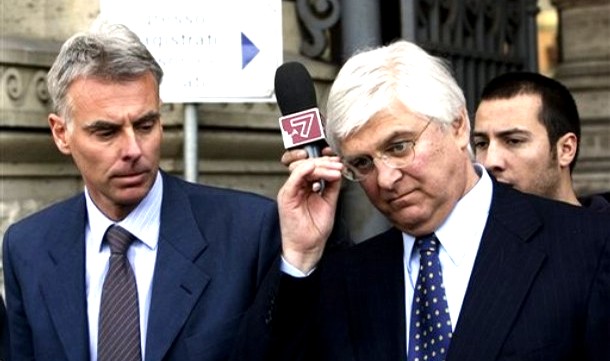
Wednesday, May 01, 2013
A Welcome To New Arrivals #1: An Experienced Trial Lawyer Recommends How To Zero In On the Truth DRAFT
Posted by Some Alibi
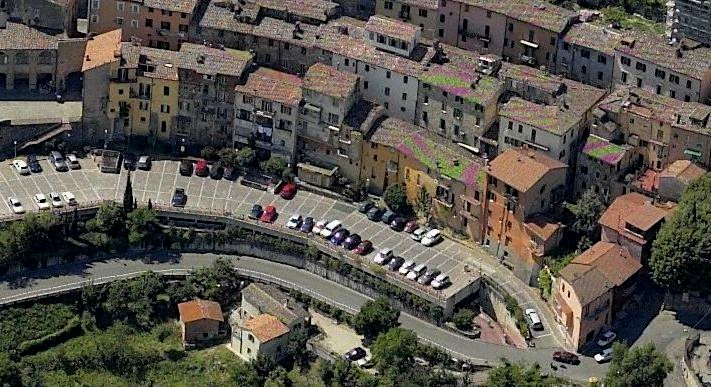
[Merediths window is seen on the top floor of the house in the lower foreground]
Welcome To Common Sense
This briefing was first posted with slightly different opening paras at the start of the annulled Hellmann appeal. New arrivals often tell us this helped them the most.
If you’ve come to this website because of the Amanda Knox book and interview, then welcome. Like all of us who come to this case, you have one key question: did they do it? The Knox book and interview seriously cherrypick the case, and perhaps haven’t helped you at all.
On the Internet, you will find people who are passionate in their defence of Amanda Knox and Raffaele Sollecito; and you will find people who are passionate in their support of an exceptionally talented girl who died, of a fine justice system previously untainted by PR, and of the prosecution’s very strong case.
Please click here for more
Although The YouTube Trailer Suggests Diane Sawyer Wimped Out And Turned All Mushy…
Posted by Peter Quennell

It could still be wrong. Trailers have been misleading before.
The interview is tonight at 10:00 on ABC. Our Main Posters Kermit and Media Watcher both have tips that could still win Diane Sawyer Pulitzer Prizes.
- Media Watcher: Diane Sawyer Interview With Amanda Knox: How To Push Back Against The False Claims And Emotion
- Kermit Powerpoint: Diane Sawyer’s Very Tough Interview With Amanda Knox: ABC Kindly Shares A Sneak Preview!
Here’s hoping. Even for Amanda Knox, our advice is usually the best. We’ll carry some sort of report on this tomorrow.
Wednesday, March 27, 2013
Getting Media Up To Speed With Hard Facts Of Complex Case
Posted by Media Watcher
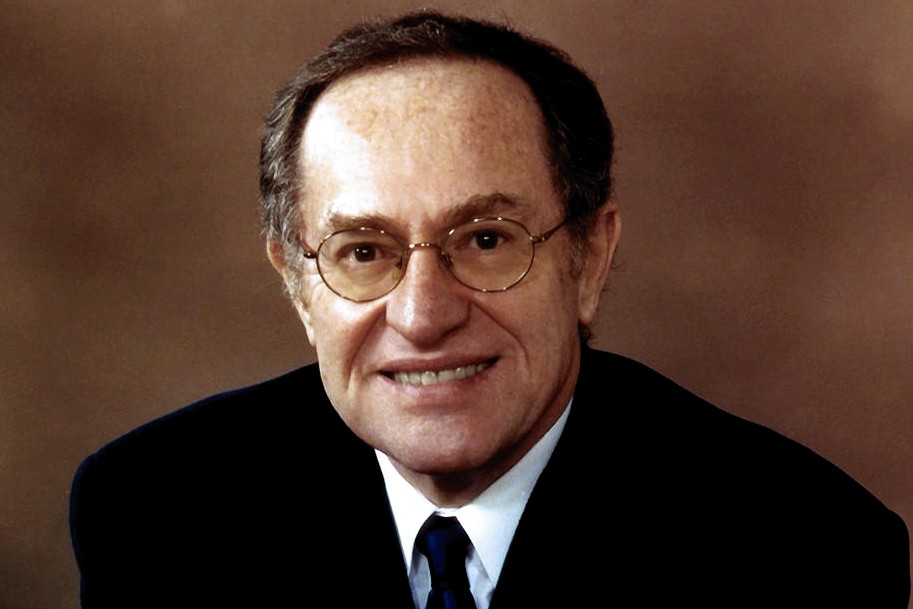
[Above: Harvard “superlawyer” Alan Dershowitz, who conceded yesterday that there IS a strong case]
Getting Back On The Rails
In the United States, with few exceptions, the media has generally accepted the spin from the defense team.
As a consequence, much of the reporting has been shallow and/or wildly inaccurate. These errors have compounded over time, which leads to a situation where the American media was completely unprepared for yesterday’s decision.
As someone who has read through all of the available court documents and much of the media and who has more than 25 years’ experience helping national media to understand complex, technical stories, here’s my take on the issues the media should consider as they continue to write about this case:
Please click here for more
Saturday, January 12, 2013
How Much To Place Blame On Guede? IMMENSE Headache For RS & AK Teams
Posted by Cardiol MD

[Photo by Andrea Vogt as in December 2010 Supreme Court decides that Rudy Guede didnt act alone]
Zero To 100% Guede Was Claimed Sole Attacker
On a scale of 0% to 100% how much of the blame for the crime against Meredith has been heaped on Rudy Guede?
Well, it certainly varies. In trial court and first-appeal court it was never ever 100%.
Seemingly very scared of the harm Guede could do to their clients, if they provoked him into telling all, defense lawyers have acted consistently since 2008 and more-so since December 2010 as if they walk on eggshells around him.
In fact among the defendants and their teams only ONCE was Guede ever blamed 100%.
Sollecito’s bizarrely-titled Honor Bound 2012 book, the factually unchecked one, which now is causing him and his defense team so much trouble, was the first instance ever among those accused to try to blame Guede for the crime 100%.
Our next post will look at the categoric claims against Guede by whoever wrote that book. Meanwhile, here and now, let’s start at the beginning.
Commencing from when they were arrested, Amanda Knox pointed decisively at a black man, but of course she pointed at the wrong one: Patrick Lumumba. Make that 0% . Not long after they were arrested, Knox and Sollecito were strongly questioning the role of one another. So 100% against each other, but still a zero against Mr Guede.
In his messages from Germany Guede blamed two hasty intruders though he had no choice but to say he was there. Perhaps 33% at this point. After Guede was captured, Sollecito implied that they were at the crime scene together because he was worried that Guede would implicate him. Make that 50%.
At Guede’s short-form trial In October 2008, Judge Micheli blamed Guede 33% too. In sending Knox and Sollecito to full trial he dismissed the lone wolf theory (never really to be revived in court again) and he tentatively believed the evidence pointed to their being equally guilty.
In fact Judge Micheli tentatively blamed Knox for instigating both the attack on Meredith and the rearrangement of the crime scene. In effect he allocated 50% of the blame to Amanda Knox and 25% each to Guede and Sollecito.
Throughout trial in 2009 the Knox and Sollecito defense teams seemed to take great care not ever to blame Guede 100%, perhaps because (for murky reasons not made public) Rudy Guede had refused to testify against their clients.
Judge Massei assigned Guede 33% of the blame as he concluded that Guede had initiated the attack but that Knox and Sollecito had wielded the knives and that one of them had struck the final blow.
During trial and thereafter, the defense lawyers for the three were often on Italian TV and as our main poster the Italian lawyer Cesare Beccaria exhaustively charted in a four-part series, each “gently” blamed the other two.
We can assume that is either 33% or 50% but never more than that.
On February 24. 2011, in the Supreme Court report, on its rejection of Guede’s final appeal of his sentence for involvement in killing Meredith, blamed Rudy Guede and two others equally. Some 33% of the blame each.
The Supreme Court relied upon three facts: the physical evidence of Guede’s presence at the flat, Guede’s actual admission of his presence, and Guede’s implicit admission of shared-guilt in his documented Skype InstaMessage to Giacomo Benedetti on Nov. 19, 2007 (“I was scared that they would say I was the only guilty person”).
In a nutshell, the situation at the start of the Sollecito and Knox appeal before Judges Hellmann and Zanetti in 2011 was this:
- The Supreme Court had decided that Rudy Guede acting ALONE could not have attacked Meredith with several knives over an estimated 15 minutes, left so little physical evidence upon her, staged the break-in via the absurd route of Filomena’s window while leaving zero DNA in her room, placed Sollecito’s DNA on Meredith’s bra clasp, engineered several traces of Knox’s and Sollecito’s footprints outside the room, and placed the mixed DNA of Meredith and Knox in several different locations outside Meredith’s locked door.
- But there remains zero evidence that perps two and three which the physical evidence strongly pointed to were anyone other than Knox and Sollecito. There’s really not one speck of hard evidence to the contrary. Defenses somewhat desperately tried to engineer some at first appeal from the seemingly perjured testimony of jailbirds Alessi and Aviello and some smoke-blowing over the DNA testing, but in terms of HARD evidence came up empty-handed. Alessi did a meltdown on the stand, while Aviello turned completely cuckoo, and Judges Hellmann and Zanetti had to invent arguments frantically to dig Knox and Sollecito out of that hole.
I have done a series of posts (to be read from the bottom upward) on the Hellmann-Zanetti outcome covering many other aspects of their strange arguments.
Back in late 2010 some of us at TJMK were impressed at the alacrity with which Judge Hellman selected Conti and Vecchiotti.
We were thinking that “he had already thought it all out” [we seem to have got that-much right], and that he was “being prudently responsive to the legal and political pressures bearing down on him, and knows the ruling also calls the defendants’ bluff.”
I had posted that the defenses of Knox and Sollecito seemed to be trying to exclude evidence that they themselves tried to destroy, essentially on the grounds that their destructive attempts failed to destroy all of it, and left behind only some of it. Their argument had boiled down to whether the disputed DNA evidence is more unfairly prejudicial than probative.
It was my opinion that because it was the defendants’ deliberate conduct that nearly succeeded in extinguishing all their DNA, any US and UK courts would admit this highly relevant evidence, and let the participants duke out its fairness, in open court, in front of a jury.
I had thought that was what the Massei Court had already done, and was what the Hellmann/Zanetti court was then doing. The Hellmann/Zanetti court was doing that - but that was not all it was doing, as we now know and regret.
I had believed that the defendants would bitterly regret their petition for such DNA Expert-Opinion Review. We should know in March 2013 if they regret it at all, let alone “˜bitterly’. So far they may not, but Sollecito’s current venture into special-pleading journalism in his book seems likely to accelerate their journey to a bitter and regretted destiny.
We were less impressed with how Judge Zanetti started the appeal hearings.
To his eternal discredit Judge Zenetti uttered words to the effect that “the only thing that is “˜certain’ in Meredith’s case is that Meredith is dead.” Nothing else. In effect, illegally promising a whole new trial at appeal level - very much frowned on by the Supreme Court.
Unless the word “˜thing’ is a mistranslation, that is not the only thing that was already certain in Meredith’s Case; Many Things were then certain in her case.
For example, it is certain that the first-ever documented references to Meredith’s scream just before she was killed had already come both from the mouth of Amanda Knox herself, and from the hand of Amanda Knox, in the case of her contemporaneous personal hand-written notes.
Guede, himself, had certainly already made a documented reference to Meredith’s scream.
It was also certain that Guede had made documented references to his actual presence when Meredith screamed.
Some of these already-certain facts inconveniently undermined Hellmann’s and Zanetti’s already-assumed conclusions, so they then proceeded in-turn to undermine the “˜reliability’ of those facts, e.g. “˜it is not certain that the scream was Meredith’s scream; it could have been someone-else’s scream’; or even Amanda’s scream?
The Massei court had exhaustively presented the evidence from all sources in their conclusion that Knox and Sollecito were the ones who shared Guede’s guilt. But Hellmann/Zanetti then contradicted ALL the previous finders-of-fact with regard to Guede, essentially using five ploys in arguing:
- That Guede was Unreliable: “for example, in the questioning before the Prosecutor, he denies being known by the nickname of Baron, “¦.so as to result in a version completely incompatible with the reality of the facts as perceived and heard…” [Is that ever giving birth to a mouse?], and
- That the Supreme Court had “held Rudy Guede to be an Unreliable person”, and
- That “therefore, among the evidence against the two accused, the testimony given at the hearing of June 27, 2011 by Rudy Guede cannot be included because it is Unreliable, nor can the contents of the letter written by him and sent to his lawyers”, and
- That concerning Guede’s documented Skype InstaMessage to Giacomo Benedetti on Nov. 19, 2007 “”¦ the contents of the chat between Rudy Guede and his friend Giacomo Benedetti on the day of November 19, 2007, also listened to by the Police, can be considered in favour of the two accused”, because “he would not have had any reason to keep quiet about such a circumstance,”
- And that “So, in the course of that chat with his friend….. Rudy Guede does not indicate in any way Amanda Knox and Raffaele Sollecito as the perpetrators…..” and “.....he would not have had any reason to keep quiet about such a circumstance….. he being…. certainly the perpetrator….. of the crimes carried out in via della Pergola, that if Amanda Knox and Raffaele Sollecito had also participated, that he would at that moment have revealed this to his friend.”
So, summarising Hellmann and Zanetti, they have absurdly argued a contradiction:
- Because of Guedes notoriously unreliability, the public evidence in which he did accuse Knox and Sollecito cannot be considered as evidence of their guilt, but
- In spite of Guede’s notorious unreliability, because Guede did not accuse Knox and Sollecito in a private conversation this must be considered as conclusive evidence of their innocence.
We are not the audience to which Dr Galati’s appeal against Hellmann and Zanetti to the Supreme Court is directed. Most of us probably have some difficulty with its legalese, translated into English, so bear with it.
Dr Galati’s appeal against Hellmann and Zanetti refers to Guede’s documented Skype InstaMessage to Giacomo Benedetti on Nov. 19, 2007 as follows:
The Hellmann/Zanetti court, “has”¦ made “¦. completely anomalous use of the Skype call, accepting it for the time of Kercher’s death, but not for other circumstances which are also extremely relevant for judgment purposes, but which have been totally ignored.
In fact, in the call, Guede recounts having heard Meredith complaining about her missing money and of her intention of asking Ms Knox, with whom she had quarrelled, for an explanation (p. 10 of the call [transcript]), of having seen Meredith look in vain for the missing money in her drawer (p. 18), then of having seen Meredith look, still in vain, for her missing money in Amanda’s room (pp. 18-19 of the call [transcript]), and of having heard a girl enter the house, who could have been one of the roommates, thus Amanda (p. 11 of the call [transcript]), while the Ivorian found himself in the bathroom, just before hearing Meredith’s terrible scream which would have caused him [59] to exit the bathroom, about five minutes after the girl’s ingress (p 12 of the call [transcript])”... .
The Court has, in practice, without reason thrown the responsibility onto Guede for throwing the rock and clambering in (see pp 121-122 of the appealed judgment): in the same Skype call, Guede, however, repeatedly denies having seen the broken window in Romanelli’s room during the whole time in which he was in the house at Via della Pergola on that evening (pp 8, 20, 34 of the call [transcript]). Not only that: Rudy Guede also said that he was at Knox’s many times”› (pp 88 of the call [transcript]).
If the Court held the Ivorian citizen to be sincere in the tele-conversation with his friend Benedetti, then why not also believe him when he denies having broken in, or when he recounts Meredith having it out with Amanda, or when he says that he had been at the latter’s place many times”›?
Dr Galati’s appeal to the Supreme Court argues that the Hellmann/Zanetti appeal judgment, apart from being manifestly illogical, is manifestly contradictory with respect to the contents of the case file referred to (Article 606(e) Criminal Procedure Code). Here is what it says about their tortured interpretations of Rudy Guede.
And in the Skype call with Benedetti, intercepted unbeknownst to him, there emerge circumstances that confirm Guede’s court declarations. The Court takes the Skype call with his friend Benedetti into examination, valuing it “šin favour of the two accused”› both for what it does not say and also for what it does say, and this it does building from one, not only unexplained, datum but which would have taken little to deny: since Rudy was outside of Italy, he was in some sense safe”› and thus could well have been able to tell the whole truth (p 40 of the judgment).
Not in the least does the Court depart from the presupposition that in this call Rudy would have been telling the truth and, because in this call he would not have named the current defendants, these have got nothing to do with the homicide. The Court does not explain, though, that even in this call Rudy was tending to downplay his responsibility and, if he had named his co-participants, that would have easily allowed, by means of investigations and subsequent interviews, the bringing out of his causal contribution and of his responsibility.
[91] Of the things said in this Skype call, the Court seems at one moment to want to value the chronological datum from 9:00 PM to 9:30 PM to affirm that this would therefore have been the time of death of Meredith; successively, though the appeal judges, following the principle of plausible hypothesis, in relation to the outgoing calls on the victim’s English handset, have moved it to 10:15 PM, but they have not altered the reliability of the time indicated by Guede.
In truth, during the course of the conversation, Rudy recounts having heard Meredith complain about the missing money and of her intention to ask Knox, with whom she had argued, for an explanation (p 10 of the call); of having seen Meredith look in vain for the missing money in her drawer (see p 18); of having seen her search, again in vain, for the missing money in Amanda’s room (pp 18 and 19 of the call) and of having heard a girl enter the house ““ who must have been one of the flatmates, thus Amanda (p 11 of the call), ““ while he was in the bathroom, a little before hearing Meredith’s terrible scream which would have induced him to exit the bathroom, about five minutes after the ingress of the girl (p 12 of the call).
And also, on the subject of the break-in in Romanelli’s room ““ thrown without explanation onto Guede’s back (see the judgment being appealed from, at pp 121 and 122) ““ can remarks by the Ivorian citizen be found in the transcription of the intercept. Guede repeatedly denies having seen the broken window in Romanelli’s room for the whole time in which he was in the house at Via della Pergola that evening (pp 8, 20, 34 of the call).
If the [Appeal Court] had held as reliable what Rudy narrated in the Skype call relating to the time in which Meredith was killed, it supplies no reason at all, on the other hand, for why it does not believe him as well when he denies [92] having committed the break-in or when he recounts the quarrel of Meredith with Amanda.”
None of this changes my own beliefs that there are even many more things in evidence that are “˜beyond any reasonable doubt’. For example:
- It is beyond any reasonable doubt that Meredith was restrained by hands other than the knife-wielding hand(s); and that Meredith was restrained by the hands of two, or three persons as she was killed.
- It is beyond any reasonable doubt that steps were taken to clean away smears made by Meredith’s blood in the place where she was killed, and tracks of Meredith’s blood transferred by her killers to other places.
- It is beyond any reasonable doubt that steps were also taken to simulate a break-in that never-was.
In the next post, we examine Dr Galati’s appeal further and the strident claims against Guede made in Sollecito’s own book which contradict some of the positions of HIS OWN LAWYERS. Note that Dr Galati has argued in the appeal that it was ILLEGAL for Hellmann and Zanetti not to have taken the Supreme Court’s ruling on three perps fully into account and having innored it or brushed past it.
Verrrry tough situation for defense counsel to be in.
Monday, April 30, 2012
Does ANY Competent Lawyer Believe RS And AK Are 100% Innocent? If So See These Questions
Posted by James Raper
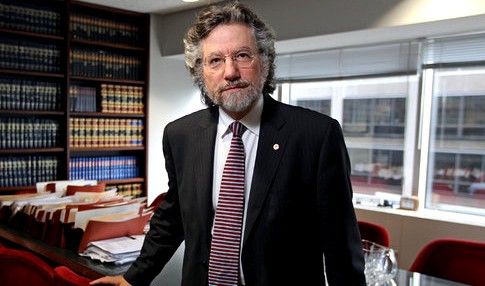
[Above: Knox defense legal advisor Ted Simon increasingly seems to have some explaining to do]
After 3 days and growing, unfortunately no sign that pro-innocence lawyers (if any) want to respond. Mr Simon? Mr Barnett? Ms Nancy Grace? (Well perhaps not you)
The Italian, US and UK lawyers who guide TJMK (of which I am one) look around and wonder: why are genuinely-convinced pro-Knox lawyers (if any) still not comprehensively answering all the open questions?
I contrast this with the various media talking heads who have offered drive-by comments without a really deep understanding of the facts of the case or Italian law.
In the law of all three countries, defense lawyers don’t need to KNOW either way whether their client is guilty or innocent. They don’t have to come out with a complete scenario to account for all the facts and point to innocence that would be the counterpart to my scenario (powerpoints - wait a few seconds to load) seemingly accounting for all the facts, which is still an unchallenged case for guilt.
But a comprehensive rebuttal would do the hard-pressed Sollecito and Knox factions a big favor, and provide a much-needed framework for the media (which is posting many incorrect legal claims), and make the Cassation appeal and the book-writing by Knox and Sollecito so much easier.
Consider the ups-and-downs of the defense legal teams on the case,
It was clear in 2008 that her lawyers absolutely didnt like Knox speaking out, offering different versions that between them made her look distinctly guilty. They didnt like the anti-Mignini campaign run from Seattle and they publicly said so - when Mr Mignini was attacked by a main speaker at an event at Salty’s they actually spoke up and publicly defended him.
In December 2008 NBC TV aired an excellent Dateline report. The main legal talking head, Ted Simon, explained that this was a really tough prosecution case to beat, and that whacking down individual points of evidence would not win the case in the public eye (justice would not be seen to be done) and that only a complete alternative explanation of the crime would do.
At trial in 2009 the defense teams did what they could with a torrent of facts and two unpredictable clients. The cross-examination of Amanda Knox on the stand mid-year in the context of Patrick Lumumba’s alleged framing must have seemed a real low-point for them, as she came across as rather flippant and chilling, and she said a number of things that all defense lawyers would probably prefer that she hadn’t.
Through the publication of Judge Massei’s report the defenses seem to have been faced with an uphill battle.
In 2011 an experienced criminal-case judge was initially appointed to preside over the first appeal. But quite suddenly, to the surprise of many in Italy and the alleged unhappiness of the judge himself, he was removed from the case, and Judge Hellman was appointed in his place.
Defence counsel would of course have had no role in that surprise change of lead judges for the first appeal, but from Day One of the appeal (spaced out to one session a week by Judge Hellman to suit one of them) the defenses seemed much happier.
The prosecution were now on occasion publicly hinting that they were now stuck with the uphill battle. The defenses now seemed the side energized and confident. But please note these three things which suggest that they knew they were not all-powerful.
- 1) They appealed on very narrow grounds, essentially on some witness testimony and a small part of the forensic evidence, and they kept well away from the multiple alibis, mobile phones and computers, and forensic evidence in the hallway, bathroom, and Filomena’s room.
2) They never argued that Rudy Guede was the lone-wolf killer in the case (the surprise preference in his report of Judge Hellman) and even put their own witnesses Alessi and Aviello on the stand to in effect try to prove otherwise.
3) Knox legal advisor Ted Simon was reduced to arguing on TV that there was no evidence of Knox and Sollecito IN the bedroom, while never accounting for the mishmash of alibis or all the mixed-blood and footprint evidence just outside the door.
As Dr Galati’s appeal and public opinion in the three countries are showing, the defences may have mostly won the second battle, with Judge Hellman’s interim verdict and sentence (Knox was still sentenced to three years), but they seem to be falling far short of winning the war for the two clients.
Now the defences again face an uphill battle.
So here we go. An opportunity for any good pro-innocence lawyer to help to win the war for Knox and Sollecito. Forget the forensics for now. I offer these several dozen questions for you and/or Amanda Knox which, truthfully answered, might put many concerns to bed.
I will be happy to post here any real attempt at answering all of these questions by any qualified lawyer who is thoroughly on top of the case - or of course any attempt by Amanda Knox herself.
1. Why did you not mention the 16 second 12.07 phonecall to Meredith’s English phone on the 2nd November in your e-mail? When explaining why you made this call, please also explain why it was to the English phone rather than Meredith’s Italian phone which you knew Meredith used for local calls?
2. Why did you not mention this call when you phoned Filomena immediately afterwards?
3. Why did you make so little effort to contact Meredith again after being told by Filomena to do so. Remember the logged 3 and 4 second phone calls?
4. Why did you tell Filomena that you had already phoned the police when neither you, nor Raffaele, had.
5. Can you and will you explain the contradiction between your panic at the cottage (as described in the e-mail) and the testimony of all the witnesses who subsequently arrived that you appeared calm, detached and initially unconcerned as to your friend’s whereabouts or safety?
6. Why did you tell the postal police that Meredith often locked her bedroom door, even when it came to taking a shower, when this was simply not true, as Filomena testified?
7. Can you and will you explain why you did not try either of Meredith’s phones at the cottage if you were indeed in such a panic about Meredith’s locked door?
8. Can you and will you explain how you knew that Meredith’s throat had been cut when you were not, according to the witnesses’s testimony, a witness to the scene in Meredith’s bedroom after the door had been kicked in and, with the exception of probably a postal police officer or the ambulance crew, no one had looked underneath the duvet covering the body when you were there?
9. What made you think that the body was in the cupboard (wardrobe) when it was in fact to the side of the wardrobe? Were you being flippant, stupid, or what, when you said that? Do you think it just a remarkable coincidence that the remark bears close comparison to the crime scene investigators conclusions, based on the blood at the scene, that Meredith had been shoved, on all fours, and head first, at the door of the wardrobe? She was then turned over on the floor and moved again. How did you know that there was any position prior to her final place of rest?
10. Will you ever be able to account for the 12.47 pm call to your mother in Seattle ( at 4.45 am Seattle time)? Do you remember this now because it was not mentioned in your e-mail nor were you able to remember it in your court testimony?
11. Why do you think Raffaele told the police ““ contrary to your own alibi that you had spent the whole time with Raffaele at his apartment ““ that you had gone out at 9 pm and did not return until 1 am?
12. Did you sleep through the music played for half an hour on Raffaele’s computer from 5.32 am?
13. Were you telling the truth when you told the court that you and Raffaele ate dinner some time between 9.15 and 11 pm? Can you not narrow it down a bit more? The water leak occurred, you said, whilst washing up dishes after dinner. Why then did Raffaele’s father say that Raffaele told him at 8.42 pm about the water leak whilst washing up dishes?
14. What was the problem about using the mop, rags, sponges etc already at Raffaele’s apartment, to clear up a water spill? Why was the mop from the girl’s cottage so essential and if it was, why not collect it immediately since it was just a short distance away?
15. Why, when you knew that you were going to Gubbio with Raffaele on the 2nd November, did you not take a change of clothing with you, if needed, when you left the cottage on the afternoon of the 1st?
16. Why did you need a shower at the cottage when you had already had one at Raffaele’s apartment the previous evening?
17. If you had needed one again why not have it at his apartment, in a heated apartment, before you set off, or on your return, rather than have a shower on a cold day, in a cold flat?
18. Why did you not notice the blood in the bathroom, and the bloody footprint on the bathmat, until after your shower? If the blood you then observed was already diluted and faded, how do you explain this?
19. Do not ignore your blood on the faucet. In your own testimony you said that there was no blood in the bathroom when you and Raffaele left the flat on the afternoon of the 1st. What is your considered take on this now? Did your ear piercings bleed when having that shower or drying afterwards? If so, why were you not perfectly clear about the matter in your e-mail? But then again you said that the blood was caked dry, didn’t you?
20. Why did Raffaele say that, on entering the flat with you, Filomena’s door was open and he saw the damage and mess inside, but you said, in your e-mail, that Filomena’s door was closed when you returned at 10.30 am? Did you subsequently look inside on that occasion, or not? It’s just that if you did, then why did you not mention the break in to Filomena prior to you and Raffaele returning to the cottage?
21. You are a creative writer so please explain. What is the point of the word “also” in the following extract from your e-mail? “Laura’s door was open which meant that she wasn’t at home, and Filomena’s door was also closed”.
22. In your trial testimony you mentioned shuffling along the corridor on the bathroom mat after your shower. From the bathroom to your room. Because there was no towel in the bathroom. You had left it in your bedroom. Then back again. Why is this not mentioned in your e-mail?
23. In your e-mail you stated that you changed for your shower in your bedroom, and then afterwards dressed in your bedroom. That makes sense. What you don’t explain is why, if you towelled and dressed in your bedroom, there was any need to shuffle back to the bathroom on the bathmat. Why not just carry it back?
24. But why, in the same testimony, did you then change your mind as to where you had undressed for your shower? Not in your bedroom - saying so was a mistake you said - but you did not say where. Some people might think, uncharitably, that your change of mind was necessary to incorporate the double bathmat shuffle.
25. Were there any things that you disliked about Meredith? Be honest because we know from her English friends and other sources that there were things that she disliked about you.
26. Why are pages missing from your diary for October?
27. Once again, and this time so that it makes some sense, please explain why you permitted the police, on your say so, to believe that poor Patrick Lumumba was involved in Meredith’s murder. Clearly, had you been at the cottage you would have known that he was not, and had you not been there you could not have known that he was.
There are actually over 200 open questions on this site, and I can think of others, but I consider these between them to be the core several dozen that relate to the quirks,contradictions, omissions and inconsistencies in Amanda Knox’s own account and behaviour. Answer all of these and in the public eye Amanda Knox really could be home free.
Sunday, March 18, 2012
Could A Growing Asymmetry Between Raffaele And Everybody Else Be Ensuring No Sleep In Seattle?
Posted by Peter Quennell

[Louise Burke, Jen Bergstrom, and Tricia Boczkowski, top editors at Sollecito publisher Gallery Books]
Amanda Knox seems to have had a history of putting her foot in it and then (sometimes) when she realizes it she tries to make amends.
That seems to be the arc of her Berlin experience where she upset people by quitting a plum intern job at the parliament after a day and then retroactively at least worrying about it. That may have been what she was doing at the first meeting with her parents in Capanne prison when they very quickly shushed her up.
Meredith seems to have found Knox hard to take with her noise and grubbiness and sharp elbows and general pushiness. But Amanda Knox was losing her few new friends in Perugia fast, and possibly her job in Patrick’s bar, and Meredith seems to have fatefully banked on Amanda Knox coming full circle soon.
There are instances recorded almost to the end where they both seemed to try to get along, although Meredith may have brushed Knox off on Halloween night when Knox made unanswered calls, maybe to ask if she could tag along.
Enter Sollecito.
Seemingly a classic loner with no close friends in Perugia, no previous genuine deep relations with girls, apparently no prior sex, a year or two behind the rest of his class in completing his degree, with serious time given to beastie porn and Japanese anime and Japanese manga. Believed to have had a history of cocaine use with some incident on record back in Bari. Loves knives.
Seemingly forever kept on a very short string by his father, who called him on the phone at least once daily, and who made sure to keep his son’s bank balance on a level with Raffaele’s legitimate monthly expenses.
Seemingly already nervous prior to Meredith’s death that Amanda Knox might soon dump him. That after less than one week.
Our Italian poster ncountryside translated these statements by Dr Sollecito which seem to show Francesco trying hard to get a grip over his slippery son.
From a family conversation recorded in Capanne prison
And then this f@cking knife that you carried back and forth .... I told you about leaving it at home .... You’re an idiot from this point of view .... aren’t you? .... and then the f@cking point that you could have avoided the [marijuana] joints .... You promised a few years ago about it, didn’t you? You gave us your promise, to me and to your sister that you would not have used them again, and instead you have not given a f@ck .... is that clear?”
From another family conversation recorded in Capanne prison
If the investigators are finally realizing what the real dynamics of the matter is ... automatically understand that you have nothing to do with [rude in italian] ... Do you understand? ... Amanda can be more or less involved in this matter ... more or less I do not know and do not give a damn ...
She will know something ... precisely ... especially considering all the versions that she has given, maybe she has not told the right one because she was worried about what this character the little negro [i.e. Patrick Lumumba] has managed to do, something like that ... do you understand what I mean? ... But you have nothing to do with [rude in Italian] ... and they understood ... now this morning or Monday there will be also the checking of your computer ... they have already cloned the hard disk ..
If Amanda was home ... if she was out, wtf were you doing? ... were you at the computer? ...... We cannot understand, this [=AK] within three days, when she went to the questura ... she has four to five different versions ... she has pulled in the little negro a@@hole ... Is a strange personality this girl, isn’t it?.
In his second and third alibis Sollecito definitely seemed to throw Knox under the bus.
It was only after hearing of Sollecito’s second alibi from police interrogators that Knox headed off down the slippery slope that now results in a confirmed three-year sentence for her and calunnia trials for both herself and her parents.
It was right then that Knox pointed the finger at Patrick Lumumba, in her own second alibi when still only a witness.
Upon his release by Judge Hellman, Raffaele Sollecito adopts a high and surprisingly jubilant “catch me if you can” profile not dis-similar to that which has been the downfall of many a psychopath throughout history.
He goes on national TV and avoids all the hard questions and he bristles with narcissistic bravado. He makes several statements about himself and Knox from his seclusion in Bisceglie north of Bari, which his father then publicly tries to pull him back from.
A seemingly naive ghost-writer, Andrew Gumbel, is invited in to capture Sollecito’s immortal thoughts, and he seem to have instantly started to mirror Sollecito’s extreme bravado.
More or less the opposite of the cautious, subdued book approach of the Knox camp. Although she may not have wanted this, Amanda Knox will be tied forever to Sollecito in the opportunistic, self-serving title: “Presumed Guilty: My Journey to Hell and Back with Amanda Knox”.
Book announcements are totally mute about all the legal trouble headed down the pike toward himself and Knox and their two families. The publisher’s announcement makes this inaccurate statement:
“Sollecito was an unwilling participant in a case that riveted the world. The Italian media convicted the young couple before any evidence had even been heard,” Gallery Books said in a statement. “Over and over, Sollecito came under pressure to change his testimony and get himself off the hook, but he refused to betray Amanda and he refused to lie.
“In “˜Presumed Guilty,’ Sollecito will finally tell his side of the story “” from his first meeting with Amanda Knox, to his arrest, prison time, subsequent release, and current relationship with the woman he stood by through the worst ordeal of both their lives.”
Really?! No, in fact Sollecito threw Amanda Knox under the bus as soon as he was leaned on, in his alibis two and three. He left her under the bus throughout the whole trial. Even after she rather desperately reached out to him in Capanne prison. And he lied again and again and again. Besides:
- Sollecito seems to show no concern at all that Perugia’s formidable chief prosecutor Dr Galati has filed a devastatingly strong appeal with the Italian Supreme Court.
- Sollecito seems to show no concern at all over his own family’s upcoming trial or the fact that they might end up in prison (which could cause his father to lose his medical license).
- Sollecito seems to show no concern at all that, for over-vigorously trying to defend him, his sister Vanessa has now permanently lost her plum job with the Carabinieri.
And now? Well, now there is a new report from the UK press, which seems to keep stringers permanently on the ground in Seattle and may have a direct pipeline to the Knox-Mellases. The report includes this:
Amanda’s new boyfriend, musician James Terrano is understood to be unhappy about Raffaele’s arrival.
James Terrano has himself been very cautious. He is unlikely to have let that damning remark leak out without a heads-up to Amanda Knox and her family. This seems yet another sign that the secret Seattle meetings are not simply a lovefest.
Both families seem to be struggling with a loose cannon called Raffaele.
Monday, October 03, 2011
Is The Raffaele Sollecito Defense Team About To Separate Him From A Radioactive Amanda Knox?
Posted by Peter Quennell
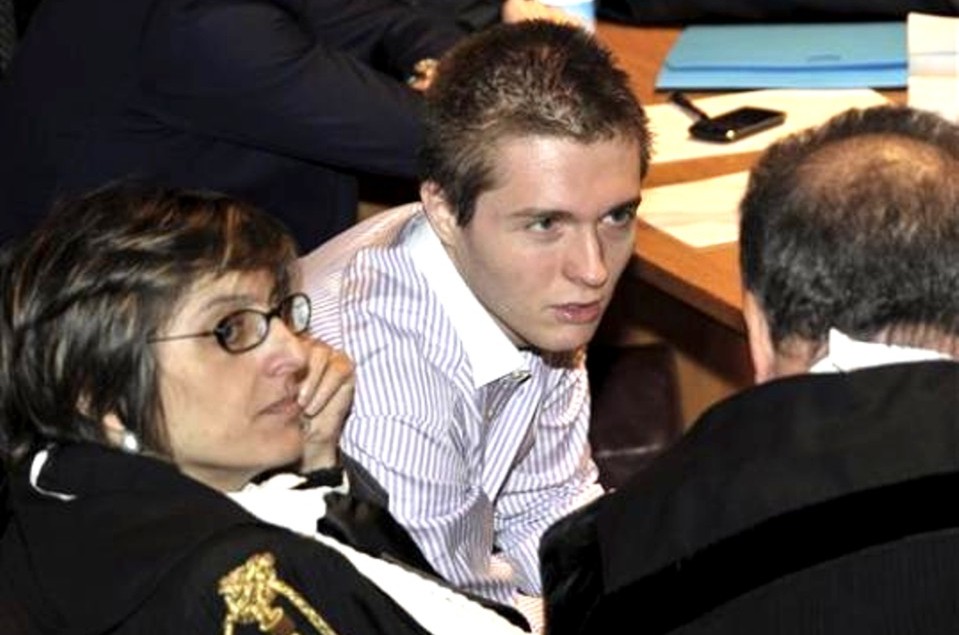
Sollecito has at least five advantages over Knox in what may be the final day of court tomorrow.
First, the smartest and most influential of all the lawyers in MP Giulia Bongiorno. Second, a relatively attractive family which has run a low-key smiling campaign. Third, relatively little evidence (the bra clasp and footprint) placing him at the scene of the crime and unlike Knox no alibi that says he was there.
Fourth, no obvious motive for either the murder or the cleanup compared to the many possible motives for Amanda Knox. And fifth, a weak wishy-washy personality on which Bongiorno has already played, casting Knox as the lead player in the drama and Sollecito as either accidentally there or not at all.
The mood does seem to be moving against Amanda Knox now as the extreme arrogance of the million dollar campaign sinks in. And if her “spontaneous” remarks to the court tomorrow follow her usual pattern, they will yet again make her look callous and concerned only about herself.
Several reports are out now in Italian harking on these themes. This report by the Associated Press with a possible nudge from the Sollecito team gives a sense of what the Italian reports are saying.
Even in Sollecito’s native Italy, it is Knox who commands the most media attention. Two prominent celebrity and gossip magazines, “Oggi” and “Gente,” put Knox on their covers during the final week of arguments in the appeals trial, and newspapers characterize him as being in the background.
Not even prosecutors have portrayed Sollecito as the main protagonist in the murder of Meredith Kercher on Nov. 1, 2007. According to their version, Sollecito held Kercher from behind while Knox stabbed her and another man tried to sexually assault her. Ivorian immigrant Rudy Guede was convicted in a fast-track trial and saw his sentence cut from 30 years to 16 years on appeal.
Attention during the investigation focused intensely on the two young female roommates as the world and prosecutors searched for a motive. Knox was portrayed as sexually promiscuous and lacking inhibition, while at the same time working hard to support herself and trying to learn Italian; Kercher was depicted as more serious and studious, who had at the end of her life began to chafe at her American roommate’s sloppiness.
The good girl/bad girl dichotomy drove headlines across the globe, while Sollecito “” the mild mannered boyfriend “” was largely overlooked in a supporting role.
It’s a role that his defense lawyer plays up. Sollecito is the son of a wealthy doctor from southern Italy who hired a crack legal team to defend his son. It’s led by Giulia Bongiorno, who defended former Italian Premier Giulio Andreotti on charges of mafia association.
“It’s not by chance that Raffaele arrived in this trial as the boyfriend. Nothing connects Raffaele to the crime,” Bongiorno said in her closing arguments last week. “With a girlfriend, you usually get a family. Raffaele got a murder.”
She said the few pieces of evidence in the “Amanda-centric” trial relate to Knox, not to Sollecito. “Nothing connects him to the crime,” Bongiorno said.

